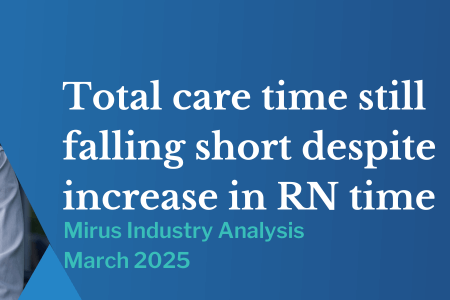5 key steps to success with AN-ACC
May 7, 2024 | AN-ACC

By Aron Wong, Senior Consultant
For the past few years, we have partnered with various aged care providers across Australia, collaborating closely with their Workforce, Funding, and Admissions teams. Our goal is to help them optimise operations and align clinical, financial, and strategic objectives. With the introduction of AN-ACC funding, mandatory care minutes, star ratings, and other legislative changes, effective coordination across these functions is more vital than ever. Drawing from our experience, we have set out five essential steps for success in navigating the AN-ACC landscape.
1. Understand your rostering capacity
While this might sound obvious, the reality, as many people know, is that managing your workforce can be complex at the best of times, with many moving parts. There could be last-minute changes to staff showing up, unpredictability of staff turnover throughout the year, minimal access to additional staffing, and high agency costs to cover any gaps among a whole heap of other complexities. Therefore, it is particularly important to understand your rostering capacity at any given point in time and to be able to project this forward in future periods to adjust to any changes in Mandatory Care Minutes while balancing your budgets throughout the year.
To achieve all of this, one must look at both the minimum contracted hours and the maximum available hours and figure out what the optimal roster is during a rostering period to address both clinical needs and care minute requirements within the home. Based on the current situation and any anticipated changes, one must then look at what the rostering strategy will be that would help to achieve all relevant objectives.
While many homes opt to maintain a stable roster with minor changes over time while managing the AN-ACC case mix to meet this goal, some homes have been opting to reassess residents’ AN-ACC and adjust the future rosters to accommodate any changes in care minute requirements.
Both strategies have their pros and cons, and it depends on your unique situation as to what strategy makes the most sense for your homes and organisations.
2. Set your star rating goals
By now, most people have heard about the Star Ratings assigned to aged care providers, but the question is, what do we do about this, and how do we achieve the desired outcomes? Sure, everyone would like to have 5 stars across every area, but this may not be practicably achievable for everyone. That is why at Mirus Australia, we have developed a Star Rating Analysis report to assist providers in determining their ideal Star Rating goal and, more importantly, how to achieve it.
As part of this process, we help educate providers on how to identify the optimal Star Rating goals to aim for and how best to achieve those. Once the optimal overall rating is determined, the next step is to look at how the Staffing Star Rating fits in with that goal and what the ideal Staffing Star rating is for each facility. Then it is crucial to use your rostering analysis (see step 1 above) to figure out how best to achieve those goals through different scenarios, as there are multiple ways to achieve the same star rating outcomes through various combinations of staffing levels relative to the Mandatory Care Minute targets. If you are finding it challenging or would like to validate your findings, we can certainly help you with this.
3. Formulate your AN-ACC strategy
Now that you understand your rostering capacity and have set your Star Rating goals based on the organisational objectives, the next thing to do is to formulate the AN-ACC strategy for the facility and organisation. What this means is that if you are keeping a stable roster as a workforce strategy, then you’ll need to target your resident AN-ACC reassessments based on maintaining a stable AN-ACC Case Mix. This will keep the Mandatory Care Minute Targets relatively unchanged from quarter to quarter so that you can maintain a similar roster in that future period.
If you have decided to adapt your rosters to a changing AN-ACC Case Mix, then you must look at how to gradually reassess residents’ AN-ACC classifications over time, or else you will have to make dramatic changes to your roster in shorter periods to accommodate significant changes in your Mandatory Care Minute Targets.
Through working closely with many aged care providers, partnering with their business to achieve their goals, I have found many providers may find it difficult to fluctuate their rosters dramatically in shorter lengths of time, so changes should be made gradually over a longer period. This means that suddenly reassessing a high number of residents in a few weeks because of a change in their conditions could potentially drastically alter rostering requirements in the following quarter.
4. Manage your admissions pipeline
While many providers may have focused on numbers 1-3 above, I have found that in more recent months, the focus is also shifting to how the AN-ACC Case Mix and Rostering requirements are affected by the AN-ACC classifications of incoming residents. For providers who have had difficulty filling beds and improving occupancy rates, sometimes they feel like they ‘have no choice’ but to take a resident in. Therefore, the AN-ACC teams may have to adapt their reassessment strategy to counterbalance any admissions decisions and the impact on the overall case mix. At the same time, the rostering team would have to consider any changes that the admissions and reassessments would have on the Mandatory Care Minutes in the following quarter and start to prepare for those effects.
On the other hand, for aged care homes with a healthy ‘waitlist’ where there is a greater choice of residents to take into the home, multiple factors often need to be considered to make the ‘right choice.’ Based on the right choice of which residents to take in, there will be different impacts on the AN-ACC Case Mix that they need to be considered to ensure adequate staff time is allocated to fulfill the duty of care to residents and achieve Care Minute Targets simultaneously.
5. Bring it all together
In our experience, this is the most challenging step to successfully managing the AN-ACC process. Providers have often found it helpful to work with us as we seek to share the current ‘Best Practice’ with the homes we work with to ensure their long-term success. When things change, we help them adapt to be prepared in advance.
It can be difficult enough to successfully manage any given function within the aged care home, but to be successful within the AN-ACC funding model, it is not only important to do each of the above steps well, but also to synchronise and coordinate the activities of the various stakeholders within the home. This ensures the achievement of all the above and other goals, while ensuring a seamless and uninterrupted experience for the residents’ care.
Moreover, the organisation may have longer-term objectives and strategies in place at the Executive and Board Levels to ensure compliance and longevity within an ever-growing and changing environment. In recent years, we have found that to be successful in this environment, it is no longer viable to ‘hope for the best’ and rely solely on incoming funding. When a stable AN-ACC process, efficient roster process and effective admissions process are combined, a stable margin on care funding should be achieved but all parts of the business, especially non-care funding should be reviewed.
For more information on how to achieve this or for assistance with implementing these strategies within your organisation, feel free to reach out to us, and we would be happy to answer any questions you may have.


